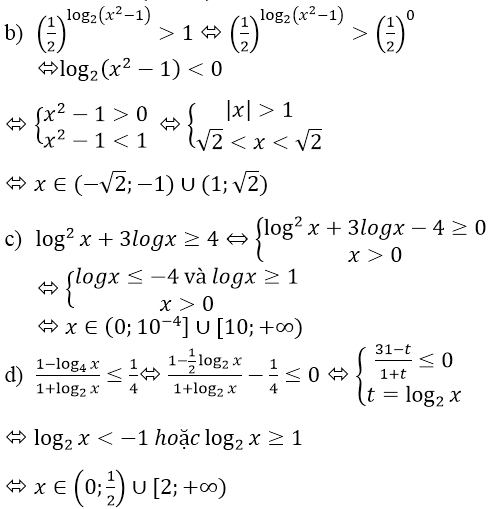Hãy nhập câu hỏi của bạn vào đây, nếu là tài khoản VIP, bạn sẽ được ưu tiên trả lời.

Lời giải:
Đặt \(\log_ab=x\Rightarrow \log_ba=\frac{1}{x}\)
a)
\(A=(x+\frac{1}{x}+2)(x-\frac{1}{x}).\frac{1}{x}\)
\(\Leftrightarrow A=(1+\frac{1}{x^2}+2x)(x-\frac{1}{x})=\left(1+\frac{1}{x}\right)^2(x-\frac{1}{x})\)
\(\Leftrightarrow A=(1+\log_ba)^2(\log_ab-\log_ba)\)
-------------------------------------------------------
b) Điều kiện: \(x>0\)
Có \(1=\log_{ab}b.\log_b(ab)=\log_{ab}b(\log_ba+\log_bb)=\log_{ab}b(\frac{1}{x}+1)\)
\(\Rightarrow \log_{ab}b=\frac{x}{x+1}\)
Như vậy:
\(B=\sqrt{x+\frac{1}{x}+2}(x-\frac{x}{x+1})\sqrt{x}\)
\(\Leftrightarrow B=\sqrt{x^2+1+2x}(x-\frac{x}{x+1})=|x+1|.\frac{x^2}{x+1}\)
\(=(x+1)\frac{x^2}{x+1}=x^2=\log_a^2b\) (do \(x>0)\)

a)
Có:
\(log_2^{\left(2^x+1\right)}.log_2^{\left(2^{x+1}+2\right)}=2\)
\(\Leftrightarrow log_2^{\left(2^x+1\right)}.\left[1+log_2^{\left(2^{x+1}\right)}\right]=2\)
Đặt \(t=log_2^{\left(2^x+1\right)}\), ta có phương trình \(t\left(1+t\right)=2\Leftrightarrow t^2+t-2=0\)
\(\Leftrightarrow\left[{}\begin{matrix}t=1\\t=-2\end{matrix}\right.\Leftrightarrow\left[{}\begin{matrix}log_2^{\left(2^x+1\right)}=1\\log_2^{\left(2x+1\right)}=-2\end{matrix}\right.\)
\(\Leftrightarrow\left[{}\begin{matrix}2^x+1=2\\2^x+1=\dfrac{1}{4}\end{matrix}\right.\Leftrightarrow\left[{}\begin{matrix}2^x=1\\2^x=-\dfrac{3}{4}\left(không-t.m\right)\end{matrix}\right.\Leftrightarrow x=0\)
b)
Với điều kiện \(x>0\), ta có:
\(log.\left(x^{log9}\right)=log9.logx\) và \(log\left(9^{logx}=logx.log9\right)\)
nên \(log\left(x^{log9}\right)=log\left(9^{logx}\right)\)
\(\Rightarrow x^{log9}=9^{logx}\)
Đặt \(t=x^{log9}\), ta được phương trình \(2t=6\Leftrightarrow t=3\Leftrightarrow x^{log9}=3\)
\(\Leftrightarrow log\left(x^{log9}\right)=log3\Leftrightarrow log9.logx=log3\)
\(\Leftrightarrow logx=\dfrac{log3}{log9}\Leftrightarrow x=\dfrac{1}{2}\)
\(\Leftrightarrow x=\sqrt{10}\) (thỏa mãn điều kiện \(x>0\)).
c)
Với điều kiện \(x>0\), lấy lôgarit thập phân hai vế của phương trình đã cho, ta được:
\(\left(3log^3x-\dfrac{2}{3}logx\right).logx=\dfrac{7}{3}\)
Đặt \(t=logx\), ta được phương trình:
\(3t^4-\dfrac{2}{3}t^2-\dfrac{7}{3}=0\)
\(\Leftrightarrow9t^4-2t^2-7=0\Leftrightarrow\left[{}\begin{matrix}t^2=1\\t^2=-\dfrac{7}{9}\left(không-t.m\right)\end{matrix}\right.\Leftrightarrow\left[{}\begin{matrix}t=1\\t=-1\end{matrix}\right.\)
\(\Leftrightarrow\left[{}\begin{matrix}logx=1\\logx=-1\end{matrix}\right.\Leftrightarrow\left[{}\begin{matrix}x=10\\x=\dfrac{1}{10}\end{matrix}\right.\)
d)
Đặt \(t=log_5^{\left(x+2\right)}\) với điều kiện \(x+2>0\), \(x+2\ne1\), ta có:
\(1+\dfrac{2}{t}=t\Leftrightarrow t^2-t-2=0,t\ne0\)
\(\Leftrightarrow\left[{}\begin{matrix}t=-1\\t=2\end{matrix}\right.\Leftrightarrow\left[{}\begin{matrix}log_5^{\left(x+2\right)}=-1\\log_5^{\left(x+2\right)}=2\end{matrix}\right.\Leftrightarrow\left[{}\begin{matrix}x+2=\dfrac{1}{5}\\x+2=25\end{matrix}\right.\Leftrightarrow\left[{}\begin{matrix}x=-\dfrac{9}{5}\\x=23\end{matrix}\right.\)

\(2^x=x^2\Rightarrow xln2=2lnx\Rightarrow\frac{ln2}{2}=\frac{lnx}{x}\Rightarrow x=2\)
Ta cũng có \(\frac{2ln2}{2.2}=\frac{lnx}{x}\Rightarrow\frac{ln4}{4}=\frac{lnx}{x}\Rightarrow x=4\) \(\Rightarrow\left\{{}\begin{matrix}a=2\\b=4\end{matrix}\right.\)
Pt dưới: \(4logx-\frac{logx}{loge}=log4\)
\(\Leftrightarrow logx\left(4-ln10\right)=log4\Leftrightarrow logx\left(ln\left(\frac{e^4}{10}\right)\right)=log4\)
\(\Rightarrow logx=\frac{log4}{ln\left(\frac{e^4}{10}\right)}=log4.log_{\frac{e^4}{10}}e\)
\(\Rightarrow x=10^{log4.log_{\frac{e^4}{10}}e}=\left(10^{log4}\right)^{log_{\frac{e^4}{10}}e}=2^{2.log_{\frac{e^4}{10}}e}\)
\(\Rightarrow\left\{{}\begin{matrix}c=2\\d=4\end{matrix}\right.\)
Bạn tự thay kết quả và tính







Chọn B